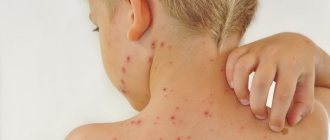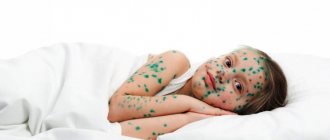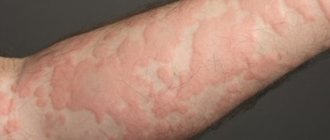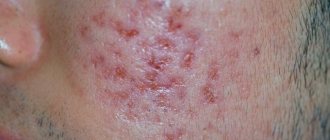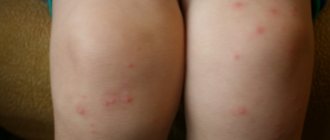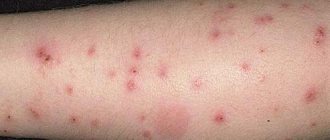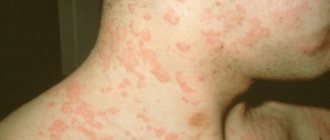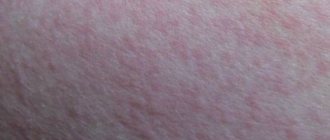What can a small red rash on the neck of an adult mean?
For both an adult and a small child, any rash that appears on the body does not mean anything good.
If we move away from environmental factors, we can talk about several diseases characterized by rashes appearing on this part of the body:
- typhus;
- measles;
- rubella;
To distinguish rubella from other types of rash, look at the photo of rubella in children.
- scarlet fever;
- meningococcemia.
It must be said right away that all the diseases listed above pose a serious danger to the human body. Therefore, after excluding factors such as environmental influences, disruptions in the hormonal system and poor hygiene, you need to contact a specialist who will take all the necessary tests and make an accurate diagnosis.
Itchy rash in the neck area of an adult
When your neck itches and a rash appears on it, this can be either an allergy or a sign indicating a malfunction of any organs. There is no need to ignore such symptoms. Consult a doctor as soon as possible to help determine the exact cause of the itchy rash in the neck.
As a rule, itching and rash on the neck appear as a result of hormonal imbalance, that is, either a deficiency or too much of a certain hormone in the body. In addition, the cause may be an allergic reaction to any product or clogged sebaceous glands. A problem with the functioning of the stomach or intestines is also possible.
Main endogenous causes
Recognizing the causes of skin rashes is a serious differential diagnostic task.
Rashes on the neck may be the first symptom to appear in many pathological conditions:
- infectious attacks;
- hormonal imbalances;
- allergic responses;
- immunological changes;
- metabolic disorders;
- nervous distress.
Many diseases occur in clinically erased or latent forms, and a skin rash may be the only symptom of their external manifestation. Therefore, any rashes that cause suspicion should be a reason to contact a medical facility - an examination by a specialist can eliminate doubts.
Why do rashes appear on the neck of an adult?
Each person can come up with a million reasons explaining the reason for the appearance of incomprehensible rashes on the neck. Men will say it's irritation after shaving or wearing a high-neck sweater, or maybe even a burn from exposure to the sun. Women are even more inventive in this regard.
No matter how much you want to turn this problem into something ordinary and frivolous, it will have to be solved anyway, and the sooner the better.
Allergy
In this situation, anything can become an allergy trigger: from detergent for washing clothes to low-quality material from which your clothes are made.
It must be said that allergies are often caused by personal care products, household chemicals and various fabrics . If it has been confirmed that the cause of the rash is a certain substance, it is necessary to either try to interact with it less or avoid contact altogether.
Here you can see photos of allergic rashes in children.
Poor hygiene
This reason is especially common among men of almost all ages. Constantly carrying out any activity and being in an active state, they do not think about cleansing their necks from excess sweat, sebum and other provocateurs of skin clogging.
Stomach or intestinal diseases
“Cloggedness” of the gastrointestinal tract requires immediate cleansing of the body; in this case, the rash on the neck will disappear on its own, leaving no trace behind.
However, if pathologies related to the functioning of internal organs have been identified, only a doctor should carry out treatment. In this case, the rash usually appears on the neck and face, but other areas of the body may be affected.
Viral infection
Symptoms of many viral diseases in adults often appear as rashes on the face and neck.
In particular, spots on the neck in the form of a rash are a characteristic sign of diseases such as:
- measles;
- rubella;
- scarlet fever;
- typhus
Hormonal changes
This phenomenon is typical for people in adolescence, as well as for women during menopause. The only difference is that different hormones are responsible for the problem. In addition to the neck, rashes associated with hormonal imbalances often appear on the back and chest.
Ointments, masks and scrubs for treatment
If you don’t want to use the previous options, then effective ointments, masks and scrubs can help. They are easy to prepare at home.
They will help get rid of acne and pimples not only in the décolleté area. But also on the face, shoulders, back.
Here are some simple but effective recipes.
Option one
3 parts olive oil with 2 parts beeswax . Mix. Add a little lecithin and 2 capsules of vitamin E , which you can buy at the pharmacy. For even greater effectiveness, add a few drops of aloe juice . Mix everything, transfer to a clean jar and store in the refrigerator. Shelf life is a month. Apply to cleansed skin every day, morning and evening.
Option two
Mix a glass of sour cream and a teaspoon of lemon juice . Add a couple of tablespoons of juice and fresh cucumber pulp. Two fresh yolks and alcoholic infusion of calendula (bottle). Beat in a mixer, transfer to a jar, and store in the refrigerator. Apply every day after washing your face twice a day.
Option three
The next recipe is a natural scrub made from honey and orange . Grind zest . Mix with natural liquid honey. Add a pinch of cinnamon (ground) and red pepper (ground). Apply to acne-affected areas of the skin. Wait 5 minutes, then massage and rinse with water.
Option four
Bran and bran help get rid of acne in the décolleté area. To prepare, you need to take a tablespoon of wheat bran , semolina , and natural honey . Colorless henna (powder) and fresh lemon juice . Mix everything well. Add raw yolk . Mix again. Apply to pimples and leave for 20 minutes. Rinse off with warm water, after massaging the area where this homemade scrub is applied with wet hands.
Option five
A mask with natural yogurt and banana has a good effect. To prepare it you need to take: one peeled banana. Two large spoons of natural yogurt. A large spoon of honey , half a teaspoon of natural lemon juice . Crush the banana, add honey and yogurt to it, mix everything. Pour in lemon juice. It can be applied not only to the décolleté area, but also to the face. Wait 10 minutes and rinse with water.
Option six
For a small number of pimples on the décolleté, a kefir-honey mask can help. It will not only cleanse the skin, but also increase local immunity and skin tone. To prepare the mask, you need to prepare 2 large spoons of kefir and a large spoon of honey . Heat kefir to room temperature. Melt honey in a water bath. Connect all components. Apply to the décolleté area and wait 20 – 30 minutes. Afterwards, rinse with cool water.
With proper and timely treatment, acne in the décolleté area goes away without any consequences. Therefore, there is no need to wait until the entire chest and neck are covered with ulcers.
You need to start acting as soon as the first pimple appears.
Elements of a rash on the neck with explanations
The rash on the body in the neck area can look very different.
The rashes vary:
- to size;
- color;
- form.
Elements of rashes can be single or in large numbers, randomly located or collected in one place. Cavity elements of the rash have a different content from other types. The rash may also peel, itch, and the patient may feel a burning sensation.
There are the following types of rashes that occur in the neck area:
- nodules;
- pustules;
- spots;
- bubbles;
- ulcers;
- blisters.
The color, structure and pattern of the skin itself change. In addition, the disease is characterized by standard areas of location of rashes on the neck.
Stains
They are characterized by a change in skin tone.
You might be interested! Molluscum contagiosum: routes of infection, symptoms and treatment at home
The following types are common:
- hyperpigmented and without pigment;
- dark or light;
- in large quantities or isolated;
- with unclear or clearly defined boundaries.
Hymeremic elements are a common symptom of diseases such as:
- allergy;
- dermatitis;
- AIDS virus;
- syphilis;
- disturbances in the functioning of the pancreas.
In addition, spots can be of the following types:
- Very bright spots can appear on the neck of people suffering from vegetative-dystonic syndrome and at the peak of nervous tension.
- Spots with marked boundaries are characteristic of patients with vitiligo.
- Moles or freckles can serve as an example of highly pigmented spots on the neck with clear boundaries.
- Spots with unclear boundaries appear in patients with liver disease or diabetes.
Nodules
Nodules are characterized by the appearance of local, up to ten millimeters, bumps on the skin. Possible hyperemia.
The appearance of nodules in the neck may indicate the presence of certain types of diseases such as:
- eczema;
- psoriasis;
- lichen;
- papillomatosis.
Painful and moving nodules, single or in large numbers, appear on the front or side of the neck as a symptom of periarteritis nodosa. This problem most often occurs in middle-aged adult men. In women, the occasional hormonal rash occurs near the corners of the jaws or under the ears.
Bubbles
Size – up to ten millimeters. The nature of the contents is serous or hemorrhagic. Bubbles can originate both in the epidermis and under it, in the skin. If the blisters are opened, ulcers and scars may remain on the skin.
Blister-type rashes on the neck may indicate the presence of the following ailments:
- allergy;
- eczema;
- chickenpox;
- lichen.
Cavity rashes larger than ten millimeters are also called blisters. The reason for their appearance on the neck is allergic dermatitis, provoked by the use of cosmetics or products containing nickel or platinum.
Blisters
Red or pink external rash. They protrude above the level of the skin and appear as a result of inflammation of the papillary layer. After a short time they disappear. Accompanied by itching.
The main causes of blisters on the neck:
- nettle burn;
- a bite of an insect;
- hives;
- toxicoderma.
If very bright blisters appear on the side of the neck, this most likely indicates the imminent onset of a drug allergic attack.
Ulcers
Elements with purulent contents are located in the epidermal or subepidermal layers.
Divided into:
- deep;
- external.
If an adult has been diagnosed with any type of impetigo, for example, characterized by the appearance of pustular rashes, this indicates a weakened immune system of the patient.
The cause of a purulent rash on the neck may be:
- furunculosis;
- folliculitis;
- blackheads
As a rule, purulent pimples and boils are located on areas of the neck covered with hair, and periodic hormonal rashes are located near the corners of the jaws or under the ears.
Pustules
A bubble with purulent contents, having a cavity and a bottom. The outer pustule has a red rim around it, deep ulcers are located in the lower layers of the dermis and can be quite large. Follicular elements are localized around the hair follicle, involving the dermis in the development of pathology.
The causes of a rash on the neck are varied, as are its forms, so recognizing the existing disease can sometimes be very difficult. Rashes of unclear nature and origin can be harbingers of dangerous diseases. In this case, visiting a doctor is mandatory, and competent treatment prescribed by him will help prevent complications.
How to get rid of it. Basis of therapy
It is recommended to start treating acne in the décolleté area as early as possible from the moment they appear. But unfortunately, many women and girls prefer to either squeeze out the ulcers or disguise them with cosmetics.
Under no circumstances should you squeeze out pimples and blackheads on your own. Of course, this procedure is carried out in many beauty salons and cosmetic clinics. But at the same time, sterility is maintained, which cannot be achieved at home.
This means that wounds after squeezing out pimples and blackheads can quickly become infected. And the inflammation spreads to surrounding tissues.
Which doctor should I contact?
Many people faced with the problem of a rash on the neck are wondering: which doctor should they contact? This is why patients usually first go to a general practitioner, who then refers them to the right specialist.
The following doctors will help eliminate rashes on the neck in adults:
- The dermatologist will determine whether the rash could be caused by an infection or whether it has another origin. Having studied the nature of the inflammatory process, the dermatologist can either treat the patient himself or refer him to another specialist;
- a cosmetologist is able to correct problems associated with poor skin care. He, as a rule, advises the patient to purchase a product for local treatment, and also prescribes a set of procedures for high-quality facial cleansing and restoration of microflora;
- The allergist will refer the patient for tests to help identify the allergen. Depending on their results, therapy will be prescribed;
- A gastroenterologist treats rashes caused by problems with the stomach or intestines. Perhaps the patient will only need a well-chosen diet, which the doctor will prepare;
- an endocrinologist will cure thyroid diseases and eliminate hormonal imbalances;
- The gynecologist will refer the patient for a hormone test, after which, if the illness turns out to be related to them, he will prescribe appropriate treatment.
The doctor the patient needs to see will be advised by the therapist, however, if you are immediately confident about the nature of the rash that has appeared on the neck, you can immediately make an appointment with the right specialist.
Stains
The elements are characterized by local changes in the color of the skin. Equally common spots are:
- hyper- and pigmented;
- hyperemic and pale;
- single or multiple;
- with clear or blurred boundaries.
Hyperemic spots on the neck are characteristic of:
- allergic and atopic dermatitis;
- toxicoderma;
- HIV and syphilis;
- pathology of the pancreas.
Bright spots appear on the neck in patients with vegetative-dystonic syndrome at the peak of nervous tension.
Well-defined depigmented spots are observed in vitiligo. Examples of clearly defined hyperpigmented spots on the neck are freckles and moles, examples of blurred spots are pigmentation due to thyrotoxicosis, liver diseases and diabetes.
